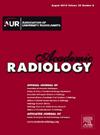MRI自动检测局灶性骨髓病变:单克隆浆细胞疾病患者的多中心可行性研究。
IF 3.9
2区 医学
Q1 RADIOLOGY, NUCLEAR MEDICINE & MEDICAL IMAGING
引用次数: 0
摘要
基本原理和目的:训练和测试一种基于人工智能的算法,用于MRI局灶性骨髓病变(FL)的自动检测。材料与方法:回顾性可行性研究纳入444例单克隆浆细胞疾病患者。在这项可行性研究中,仅包括左骨盆内的fl。使用nnDetection框架,该算法基于来自中心1的334例患者的494个FLs进行训练,并在内部测试集(36例患者,89个FLs,中心1)和多中心外部测试集(74例患者,262个FLs,中心2-11)上进行测试。计算自动确定的fl数与实际fl数的平均精密度(mAP)、f1评分、敏感性、阳性预测值(PPV)和Spearman相关系数。结果:在内外测试集上,算法的mAP值为0.44/0.34,F1-Score值为0.54/0.44,灵敏度为0.49/0.34,PPV值为0.61/0.61。在高成像质量的外部多中心测试集的两个子集中,mAP为0.45/0.41,F1-Score为0.50/0.53,灵敏度为0.44/0.43,PPV为0.60/0.71,性能与内部测试集基本匹配。在内部(r=0.51, p=0.001)和外部多中心测试集(r=0.59, p)上,自动确定的FLs数量与实际FLs数量之间存在显著相关性。结论:本研究表明,MRI自动检测FLs,从而自动评估FLs数量是可行的。本文章由计算机程序翻译,如有差异,请以英文原文为准。
Automated Detection of Focal Bone Marrow Lesions From MRI: A Multi-center Feasibility Study in Patients with Monoclonal Plasma Cell Disorders
Rationale and Objectives
To train and test an AI-based algorithm for automated detection of focal bone marrow lesions (FL) from MRI.
Materials and Methods
This retrospective feasibility study included 444 patients with monoclonal plasma cell disorders. For this feasibility study, only FLs in the left pelvis were included. Using the nnDetection framework, the algorithm was trained based on 334 patients with 494 FLs from center 1, and was tested on an internal test set (36 patients, 89 FLs, center 1) and a multicentric external test set (74 patients, 262 FLs, centers 2–11). Mean average precision (mAP), F1-score, sensitivity, positive predictive value (PPV), and Spearman correlation coefficient between automatically determined and actual number of FLs were calculated.
Results
On the internal/external test set, the algorithm achieved a mAP of 0.44/0.34, F1-Score of 0.54/0.44, sensitivity of 0.49/0.34, and a PPV of 0.61/0.61, respectively. In two subsets of the external multicentric test set with high imaging quality, the performance nearly matched that of the internal test set, with mAP of 0.45/0.41, F1-Score of 0.50/0.53, sensitivity of 0.44/0.43, and a PPV of 0.60/0.71, respectively. There was a significant correlation between the automatically determined and actual number of FLs on both the internal (r = 0.51, p = 0.001) and external multicentric test set (r = 0.59, p<0.001).
Conclusion
This study demonstrates that the automated detection of FLs from MRI, and thereby the automated assessment of the number of FLs, is feasible.
求助全文
通过发布文献求助,成功后即可免费获取论文全文。
去求助
来源期刊

Academic Radiology
医学-核医学
CiteScore
7.60
自引率
10.40%
发文量
432
审稿时长
18 days
期刊介绍:
Academic Radiology publishes original reports of clinical and laboratory investigations in diagnostic imaging, the diagnostic use of radioactive isotopes, computed tomography, positron emission tomography, magnetic resonance imaging, ultrasound, digital subtraction angiography, image-guided interventions and related techniques. It also includes brief technical reports describing original observations, techniques, and instrumental developments; state-of-the-art reports on clinical issues, new technology and other topics of current medical importance; meta-analyses; scientific studies and opinions on radiologic education; and letters to the Editor.
 求助内容:
求助内容: 应助结果提醒方式:
应助结果提醒方式:


